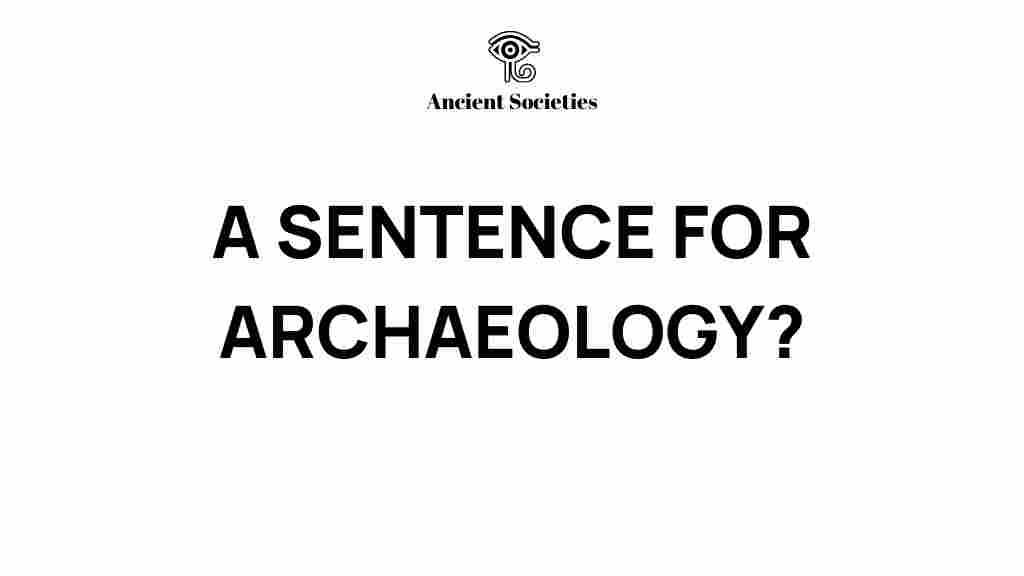Unearthing the Past: What a Sentence Reveals About Archaeology
Archaeology is a fascinating field that allows us to delve into the lives of ancient civilizations, uncovering historical records and artifacts that tell the stories of our ancestors. Each archaeological finding contributes to our understanding of history and cultural heritage, painting a vivid picture of past societies. In this article, we will explore the significance of archaeology, the methods involved in excavation, and the importance of preserving our historical treasures.
The Importance of Archaeology
Archaeology serves as a bridge to the past, providing insights into ancient civilizations that can no longer speak for themselves. By studying the remnants they left behind, we can decode their ways of life, beliefs, and social structures. Here are a few reasons why archaeology is crucial:
- Understanding Human History: Archaeological findings help us piece together the timeline of human existence, from the earliest hunter-gatherers to complex societies.
- Preservation of Cultural Heritage: Archaeology plays a vital role in preserving the cultural heritage of communities around the world, ensuring that future generations can learn from the past.
- Revealing Historical Records: Excavations can reveal documents, inscriptions, and other historical records that provide context to our understanding of history.
Methods of Excavation
The process of excavation is meticulous and requires careful planning. Here’s a step-by-step guide to the excavation process in archaeology:
Step 1: Site Selection
Before any digging begins, archaeologists must select a site based on historical research, previous findings, and geographical surveys. Factors to consider include:
- Historical significance of the area
- Accessibility and legal permissions
- Potential for discovering artifacts or structures
Step 2: Surveying
Once a site is selected, archaeologists conduct surveys using various techniques:
- Surface Survey: Observing and recording artifacts on the surface.
- Geophysical Surveys: Using technology to detect sub-surface features without excavation.
Step 3: Excavation
With a plan in place, excavation can commence. This involves:
- Carefully removing layers of soil.
- Documenting the context and location of each artifact or feature uncovered.
- Using tools like trowels, brushes, and shovels for delicate work.
Step 4: Analysis
After excavation, the findings are analyzed. This includes:
- Cataloging artifacts for further study.
- Conducting scientific tests, such as radiocarbon dating.
- Interpreting artifacts to draw conclusions about the culture and lifestyle of the civilization.
Troubleshooting Common Challenges in Archaeology
Archaeology can be fraught with challenges that may hinder the excavation process. Here are some common issues and tips on how to address them:
Challenge 1: Weather Conditions
Inclement weather can impact excavation schedules. It is essential to:
- Monitor weather forecasts and plan accordingly.
- Have contingency plans for rain or extreme heat.
Challenge 2: Site Preservation
Preserving the integrity of the site is crucial. To protect archaeological sites:
- Minimize disturbance to the surrounding area.
- Use protective coverings during adverse weather.
- Follow local regulations regarding site protection.
Challenge 3: Funding Limitations
Funding is often a significant constraint in archaeological projects. To secure funding:
- Create detailed project proposals highlighting the importance of the excavation.
- Seek grants from cultural heritage organizations or universities.
- Engage the community to raise awareness and support for the project.
The Role of Artifacts in Understanding History
Artifacts are invaluable in archaeology as they provide tangible links to the past. Each item tells a story, revealing information about the daily lives, beliefs, and technologies of ancient civilizations. Here are some key types of artifacts:
- Tools: Indicate the technological advancements of a civilization.
- Pottery: Offers insights into the diet and trade practices of the people.
- Jewelry: Reflects cultural values and social status.
Preservation of Archaeological Findings
Once artifacts are uncovered, their preservation is paramount. This involves:
- Conservation: Applying scientific methods to stabilize and protect artifacts.
- Storage: Ensuring artifacts are stored in controlled environments to prevent deterioration.
- Documentation: Keeping detailed records of each artifact’s history and condition.
Preservation not only protects individual artifacts but also the cultural heritage they represent. Without proper care, we risk losing vital pieces of history that connect us to our past.
Conclusion: The Legacy of Archaeology
Archaeology is more than just digging in the ground; it is a discipline that connects us to ancient civilizations and enriches our understanding of history. By studying archaeological findings, we gain valuable insights into our forebears, their cultures, and their contributions to the world. The meticulous process of excavation, the analysis of artifacts, and the preservation of these treasures are all crucial components of this field.
Through archaeology, we unearth not just objects, but the stories and legacies of those who came before us. As we continue to explore and protect our cultural heritage, we ensure that future generations will have the opportunity to learn from the past. For more information on archaeological methods and findings, you can visit the Archaeological Institute of America or check out our detailed articles on historical records and their importance.
This article is in the category Archaeology and created by AncientSocieties Team
